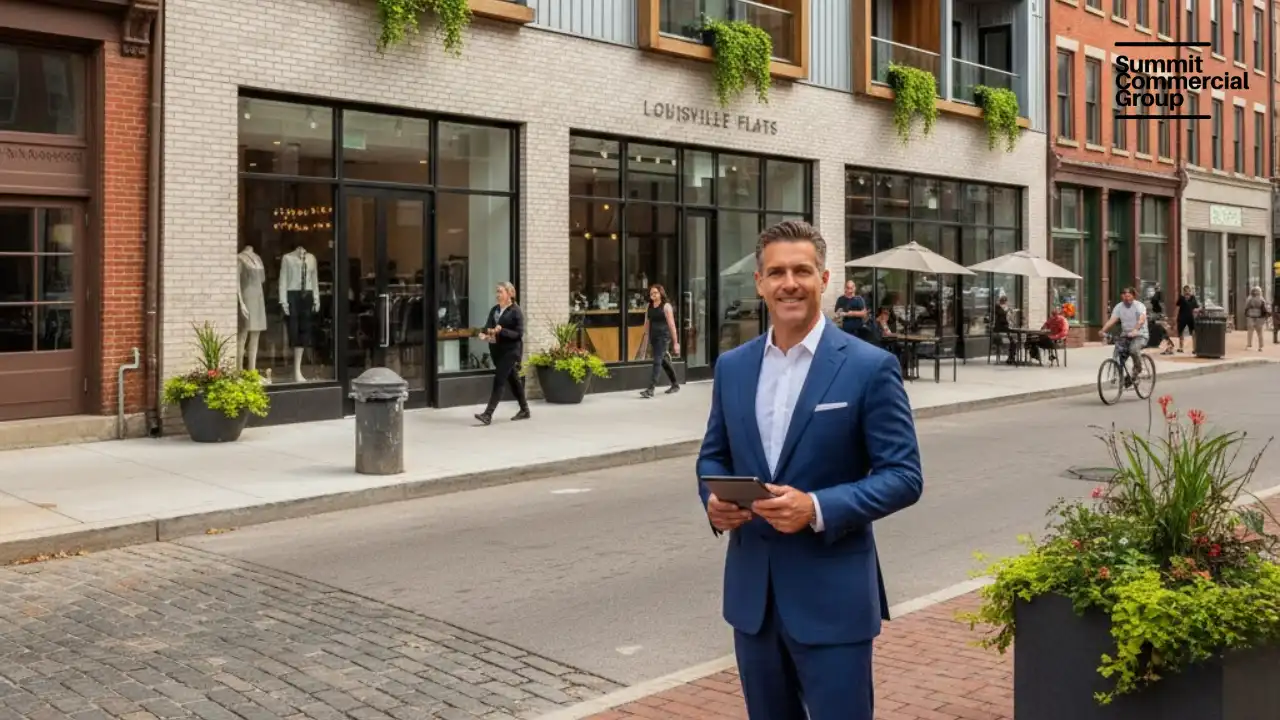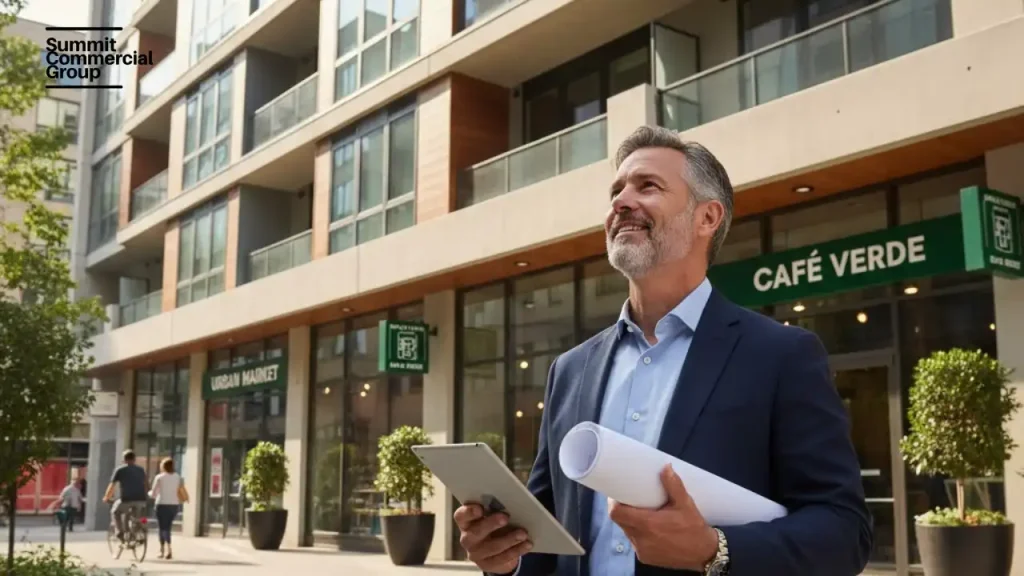If you’ve ever looked at a property deal and thought, “That could work, but only if everything goes right,” you’ll love this story. It’s about a smart investor who doubled ROI by turning a simple mixed-use building into a strong performer. The strategy wasn’t magic; it was all about timing, planning, and understanding how to make a property work harder, lessons that apply to almost any market.
Table of Contents
ToggleLouisville Commercial Property Investment Case Study
A commercial property investment case study shows how a real investor used focused planning, smart value-add steps, and steady management to grow returns over time. In this example, the investor didn’t rely on luck; they built profit by improving what was already there, step by step.
Why Mixed-Use Properties Are Powering Growth
Mixed-use properties have quietly become one of the smartest ways to invest in real estate today. These buildings combine different types of spaces, retail, office, and residential, into one property. That balance creates stability. When one part of the market slows down, the other can keep income flowing. It’s a structure that spreads risk and multiplies opportunity.
In my early years in real estate, I remember touring a building that taught me this lesson firsthand. It had a bakery downstairs, two small offices on the middle floors, and four apartments on top. At first glance, it looked tired, with cracked paint, old signs, and a lot of foot traffic that no one seemed to notice. But the numbers told a different story. The bakery never missed rent, the offices were leased to long-term tenants, and the apartments had a waiting list. That mix of income sources made the building stronger than most shiny single-use investments I’d seen. I still think about that building whenever I review a deal. It was the moment I realized that balance often beats flash.
The rise of mixed-use projects today isn’t just a trend; it’s a reflection of how people want to live and work. Tenants want convenience. Businesses want steady traffic. Investors want dependable cash flow. According to insights from PwC and the Urban Land Institute’s Emerging Trends in Real Estate® 2024 report, demand for mixed-use communities continues to grow as more people seek walkable neighborhoods that combine living, working, and leisure. A well-managed mixed-use property can meet all three needs at once. It fits modern habits where people live close to work, grab coffee downstairs, and shop within walking distance.
From an investment standpoint, mixed-use properties can deliver both capital appreciation and consistent income. The retail or office portions often cover the fixed costs, while the residential side adds predictable monthly rent. The result is a more resilient income stream that can weather economic swings better than single-purpose assets.
That’s why this case study matters. The investor saw more than just a building—they saw balance. They turned a mix of uses into a strategy that generated lasting returns.
The Investor’s Challenge: Finding Value in a Shifting Market
Every investor faces a moment when the numbers stop making sense. Prices rise, cap rates compress, and good deals seem to disappear overnight. That’s exactly where this story begins , with an investor who was struggling to find value in a market that felt tapped out.
They weren’t a beginner. They had already bought and sold several properties. But the market had changed. Single-use retail centers were producing thinner margins. Office buildings were sitting vacant longer. Even solid industrial assets were being snapped up by larger firms paying top dollar. The investor needed something different , a property that could grow income without relying on market appreciation alone.
That’s when the idea of a mixed-use asset came into play. Instead of chasing high-competition sectors, they focused on an overlooked building that combined retail on the ground floor with residential units above. On paper, it didn’t look like much. The rents were below market, half the residential units were empty, and the retail space was dated. But what caught the investor’s attention wasn’t what the property was; it was what it could become.
Understanding the Hidden Potential
The investor noticed something subtle: foot traffic in the area was improving. Small shops and cafes were starting to open nearby, and rental demand for apartments was rising. Most people saw a tired building; the investor saw timing. With a few key upgrades, they could reposition the property to attract stronger tenants and higher rents.
The concept of value-add investment is simple but powerful. You buy a property that’s underperforming, make strategic improvements, and increase its income. But doing that in a mixed-use setting requires extra care. Every change to one part of the building affects the others. Renovating apartments can disturb retail tenants. Adjusting leases in the retail space can impact long-term stability. It’s a balancing act between improving the asset and maintaining cash flow.
The Market Forces at Play
This investor also understood market cycles. Commercial real estate moves through stages , growth, stabilization, slowdown, and recovery. Instead of buying at the peak, they found a property during a soft period when most investors were cautious. That timing allowed them to negotiate a better purchase price and start renovations before demand accelerated again.
Even without focusing on any specific city or region, this principle holds true everywhere. When the market is crowded, opportunities hide in the assets others ignore. Mixed-use properties, in particular, often sit in that gap because they require more management and expertise. Yet, that extra effort can deliver outsized results.
From Hesitation to Commitment
Committing to a deal like this requires conviction. There’s always a risk that the upgrades won’t attract the right tenants or that financing terms will shift before stabilization. The investor handled this by building a conservative financial model. They assumed longer lease-up periods, added higher reserves for repairs, and left room for slower rent growth. That cautious approach gave them confidence to move forward even when others hesitated.
Lessons from the Turning Point
The investor’s biggest challenge wasn’t the property; it was perspective. When everyone is chasing the same kind of deal, it’s easy to forget that real value often sits where few people look. By focusing on a building with multiple income streams and untapped potential, they found stability in a shifting market.
In my experience, the best investments aren’t the ones that look perfect from day one. They’re the ones that make sense when others seem unsure. Markets change, but the ability to see beyond current conditions is what separates ordinary investors from great ones. This investor didn’t wait for the market to align; they built their own opportunity, one lease, one renovation, and one strategy at a time.
The Property: Downtown Louisville, Prime Mixed-Use Potential
When this investor first toured the property, they saw a structure that had more story than sparkle. It was a four-story mixed-use building with street-level retail and residential units above. The retail tenant, a long-standing local store, occupied most of the ground floor, while the upper units were only half-leased. The property had good bones but lacked vision.

Property Snapshot
To give a clear picture, here’s how the numbers looked before and after the value-add strategy:
| Category | Before Strategy | After Strategy |
| Occupancy Rate | 65% | 95% |
| Average Monthly Rent (per unit) | $1,000 | $1,350 |
| Retail Rent (per sq. ft.) | $18 | $25 |
| Annual Net Operating Income | $85,000 | $160,000 |
| Estimated Property Value | $1.2 million | $2.4 million |
These aren’t just numbers; they tell a story of renewal. Each improvement added stability, demand, and long-term value.
Key Property Features
- Prime Location: Situated in a high-visibility corridor with strong foot traffic. Proximity to other commercial tenants made it ideal for retail longevity.
- Mixed-Tenant Structure: A Combination of retail and residential allowed for risk diversification and stronger year-round income.
- Undervalued Lease Rates: Rents were 15–20% below market, leaving clear room for growth.
- Solid Structural Integrity: The building required only cosmetic and functional upgrades, not a full-scale renovation.
Why the Property Stood Out
The property stood out because of its blend, not its perfection. Many investors pass over properties that need minor repositioning because they look too much like work. However, this investor understood that even a few strategic changes could change the entire value profile.
The location had consistent daily traffic, and the surrounding area showed early signs of revival. A few new businesses had opened nearby, and rental demand for smaller residential units was rising. That meant the timing was ideal for turning an average mixed-use asset into a profitable investment.
How the Investor Approached It
The investor didn’t jump in blindly. They analyzed rent rolls, tenant credit, lease terms, and neighborhood demographic trends. They spoke to local brokers and reviewed comparable properties. Once they saw how much the building lagged behind its peers in rent and occupancy, the upside became obvious.
The most successful real estate stories often come down to simple math backed by sharp observation. In this case, the property didn’t just fit the numbers , it fit the investor’s long-term goal: steady, diversified income with clear potential for appreciation.
Raphael’s Strategy: Creating a Value-Add Plan That Worked
Once the investor had secured the property, the next step was all about execution, unlocking value without overextending time or capital. This is where strategy met precision. The investor didn’t rely on luck or short-term trends. They applied a structured plan rooted in solid commercial fundamentals, and it worked.

Setting a Clear Roadmap
The first step was to build a roadmap with measurable goals. They didn’t just say, “Let’s fix it up.” They outlined exact targets: improve occupancy, lift rental income, enhance tenant quality, and refresh curb appeal. Every improvement was tied to a financial outcome.
- Goal 1: Raise overall occupancy from 65% to above 90%.
- Goal 2: Bring rent levels in line with comparable properties within 12 months.
- Goal 3: Modernize retail frontage to increase visibility and attract premium tenants.
- Goal 4: Refinance or sell once income growth reaches a sustainable level.
Step 1: Optimize Occupancy and Tenant Quality
Empty space is a cost, not an opportunity, unless you know how to fill it wisely. The investor started by improving tenant screening and marketing the vacancies to attract businesses aligned with local demand. Residential units were repositioned to appeal to younger professionals seeking mixed-use living.
Older tenants with expiring leases were offered new terms that reflected fair market rates, while new tenants were brought in at slightly higher rents, creating steady upward movement in income without disruption.
Step 2: Strengthen Cash Flow Through Smarter Leasing
Next came lease restructuring. The investor focused on longer lease durations for retail tenants and staggered lease expirations to avoid cash flow dips. On the residential side, shorter initial leases allowed rent adjustments as improvements took effect.
They also introduced triple-net leases (NNN) for retail tenants where possible, reducing maintenance and tax burdens on ownership. The result was predictable income and reduced operational stress, the kind of foundation that serious investors aim for.
Step 3: Leverage Market Momentum for ROI
The final move was a strategic timing. Once the building reached near-full occupancy and cash flow stabilized, the investor refinanced at a higher valuation. This allowed them to pull out equity while still retaining ownership. The decision wasn’t driven by emotion but by math , when income doubles, value follows.
In the end, this wasn’t about chance. It was about turning structure into strategy. Each improvement, lease, and decision moved the property closer to one goal: stronger performance and long-term financial freedom.
The Results: 100% Occupancy and a Doubled Return
The true test of an investment isn’t what it looks like on paper; it’s how it performs over time. Within just a few years, this once-overlooked property became a benchmark example of how focused management and smart repositioning can transform an asset. What began as a 65% occupied building struggling to stay afloat became a high-performing mixed-use property with steady income and long-term stability.
From Vacancy to Vitality
The biggest transformation came from occupancy. After renovations and improved tenant targeting, the property reached full capacity. The retail space attracted a dependable tenant that brought consistent foot traffic, which in turn boosted the residential appeal. The apartments filled quickly, with rent increases that stayed within market range yet significantly outperformed the property’s previous levels. The building that once felt half-empty was now full of life and activity.
This shift didn’t happen overnight. It took months of planning, outreach, and steady adjustments. But every improvement fed into the next. As the ground-floor retail grew busier, the upper floors became more desirable. The better the tenants, the better the income, and the stronger the property’s reputation in the local market.
Financial Impact and ROI
Financially, the results spoke louder than any sales pitch ever could. The investor had originally acquired the property for about $1.2 million. After stabilizing operations, raising rents, and cutting unnecessary costs, the building’s net operating income nearly doubled. When appraised, the property’s new value stood close to $2.4 million.
This was more than a gain in numbers; it was proof of a disciplined process. The investor didn’t chase speculation; they created tangible value. Through refinancing, they were able to extract equity without selling, essentially locking in a return that mirrored a full disposition. This move not only rewarded patience but also created flexibility for future investments.
Long-Term Stability
Beyond the short-term win, the investor built a lasting foundation. Stable leases, reliable tenants, and strong property management ensured that income remained consistent even after the refinancing. By combining a solid location, mixed-use diversity, and careful planning, the investor positioned the asset to perform for years to come.
The result was more than just a doubled ROI , it was a masterclass in controlled growth. This case reminds us that real estate rewards strategy, not speed, and that true profit often comes from patience, timing, and thoughtful execution.
What This Means for Investors
This success story proves one thing: great investments aren’t about luck; they’re about vision. The investor didn’t wait for a “perfect” market or chase trendy asset classes. They built value through discipline and awareness of what the market truly needed. For investors everywhere, mixed-use properties represent a practical way to balance risk and reward.
The beauty of mixed-use investments lies in their flexibility. When one income stream slows, say, retail, residential, or office rent can offset it. That’s why smart investors gravitate toward assets that can adapt to shifting demand. The takeaway here is clear: success favors those who look beyond short-term cycles and focus on long-term fundamentals.
Another key lesson is scalability. Once a system for repositioning and managing a mixed-use property is refined, it can be repeated. Whether it’s a small building or a larger complex, the same principles apply: identify value gaps, improve income, and time the market. Investors who adopt this mindset tend to outperform those chasing short-lived opportunities.
Understanding the Investor’s Edge
The real differentiator isn’t access to capital, it’s insight. This investor understood their market, saw unmet needs, and acted decisively. They didn’t buy a property just because it looked good. They bought it because they knew how to make it better. That level of strategic clarity is what separates investors who hope for returns from those who create them.

How Raphael Helps Clients Find the Same Success
At its core, this story mirrors how experienced advisors like Raphael approach commercial real estate. The goal isn’t to “sell” a property, it’s to shape a strategy that aligns with each client’s investment goals. From identifying underperforming assets to structuring leases and managing repositioning, the process is built on precision, not guesswork.
Raphael’s approach focuses on three pillars: understanding client objectives, reading the market, and engineering value. Every recommendation stems from data and local insight, not speculation. By combining financial modeling with hands-on experience, he helps investors move from opportunity to execution with confidence.
What makes this process stand out is its adaptability. No two investors are the same. Some seek stable income; others want aggressive growth. The strategy changes, but the principle remains: invest with intention and understand the levers that move value.
If you’re considering commercial investment, this is the perfect time to explore your options. The best opportunities often appear just before the market shifts, and guidance from someone who’s navigated those cycles can make all the difference.
Final Thoughts: Turning Market Insight into Smart Action
Real estate isn’t just about buying property; it’s about buying potential. This investor’s journey shows how careful planning, patience, and purpose can turn a simple idea into lasting profit. It’s easy to think success requires a booming market or a lucky break. In reality, it’s built on quiet discipline, analyzing the right metrics, improving the right features, and holding steady when others hesitate.
Every investor has access to the same listings and tools. What makes the difference is the ability to see connections others miss, to notice where demand is rising, where value can be added, and where timing turns a good deal into a great one.
For anyone serious about building wealth through commercial real estate, the lesson is straightforward: study the market, trust the process, and focus on fundamentals. Strategy will always outperform speculation.
When you combine vision with execution, you don’t just invest, you create results that last.
Final Thoughts
This case study proves that real estate success doesn’t come from luck; it comes from clear strategy, patience, and timing. The investor didn’t find a perfect property; they made one. By improving income, managing risk, and understanding the market, they turned an average building into a high-performing asset.
For anyone thinking about investing, the lesson is simple: focus on value, not hype. The best opportunities often look ordinary at first glance , until the right plan turns them into something exceptional.
Ready to Explore Smart Commercial Investments?
Ready to explore smart commercial investments? Work directly with Raphael Collazo, a local commercial real estate expert, to uncover high-performing opportunities and build lasting value in your portfolio.
Frequently Asked Questions
What is a mixed-use property, and why is it a smart investment?
A mixed-use property combines different types of spaces, typically retail, office, and residential, within a single building or development. This setup spreads risk across multiple income sources. If one sector slows, another can sustain overall revenue. Investors like them because they offer steady cash flow, stronger tenant diversity, and long-term appreciation potential.
How did the investor in this case study double their ROI?
The investor bought an underperforming property, improved its management, updated leases, and boosted occupancy. By raising income and stabilizing cash flow, the building’s value naturally increased. When the property was refinanced, the investor was able to access equity equal to twice their initial investment, effectively doubling ROI without selling.
What makes mixed-use properties different from other types of real estate?
Unlike single-use buildings, mixed-use assets serve multiple market needs at once. They attract a broader tenant base and often thrive in evolving urban or suburban areas where people want convenience, living, working, and shopping in one place. This diversity creates a more stable income and a higher overall demand.
How long does it take to see returns on a value-added investment like this?
Typically, a well-planned value-add strategy begins to show returns within two to five years. The timeline depends on the property’s condition, the scale of renovations, and how quickly new tenants are secured. The key is patience , real estate wealth builds through consistent improvement, not overnight gains.
Can smaller investors use the same strategy?
Absolutely. While large investors may have more capital, smaller investors can apply the same principles on a smaller scale. The process is the same: buy below market, improve operations, enhance appeal, and manage cash flow wisely. Even a modest property can produce strong returns when approached strategically.

